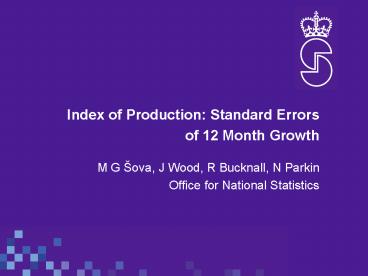Index of Production: Standard Errors - PowerPoint PPT Presentation
1 / 22
Title:
Index of Production: Standard Errors
Description:
deflation of sales. seasonal adjustment. smoothing. An Overview the Main Steps of IoP Estimation ... Deflation to produce. volumes. ABI. sales (Values in base ... – PowerPoint PPT presentation
Number of Views:44
Avg rating:3.0/5.0
Title: Index of Production: Standard Errors
1
- Index of Production Standard Errors
- of 12 Month Growth
- M G ova, J Wood, R Bucknall, N Parkin
- Office for National Statistics
2
Overview
- What is the IoP?
- Construction of the IoP
- Approximation of the IoP
- Variance estimation method
- Results implications
3
The Index of Production
- IoP is a volume index
- Measures growth (or decline) in production
- Covers manufacturing, mining and quarrying, and
energy supply - Published monthly
4
IoP 1968 to 2005
5
Main Users of the IoP
- Bank of England and HM Treasury
- National Accounts
- Eurostat
6
Aim of the Standard Errors Project
- All index numbers measure growth (or decline)
from some reference period - Users are more interested in growth over a fixed
period (e.g. 1 month, 1 year, etc.) than index
levels - Estimate standard errors of 12 month growth
(avoids seasonality issues) - For a quality report on the IoP for Eurostat
- Growth from September 2003 to September 2004
7
Construction of the IoP
- The IoP is derived mainly from sales data
- Some volumes are used but no input proxies
- Complex methods for
- deflation of sales
- seasonal adjustment
- smoothing
8
An Overview the Main Steps of IoP Estimation
Non-ONS sources HMRC, DTI, DEFRA. (Volumes)
Seasonal adjustment X11ARIMA
Adjust ad hoc
ONS Sources MPI, QSI. (Values)
Deflation to produce volumes
Stock Adjust
Merchanted goods adjustment
Producer and export price indices
Smoothing
Lagging and aggregating
Deflators
Knowledge of IoP team
Indices at class level
ABI sales (Values in base year)
Aggregation
Produce GVA Estimates at class level
Weights for the IoP
Indices at all levels
9
Kokic (1998) Simplification of IoP
Non-ONS sources HMRC, DTI, DEFRA. (Volumes)
Seasonal adjustment X11ARIMA
Adjust ad hoc
ONS Sources MPI, QSI. (Values)
Deflation to produce volumes
Stock Adjust
Merchanted goods adjustment
Producer and export price indices
Smoothing
Lagging and aggregating
Deflators
Knowledge of IoP team
Indices at class level
ABI sales (Values in base year)
Aggregation
Produce GVA Estimates at class level
Weights for the IoP
Indices at all levels
10
Approximate IoP
- Includes
- main inputs (sales volume data)
- deflation (producer export prices)
- stock adjustment (with lagged deflation)
- Omits
- merchanted goods adjustments
- ad hoc adjustments
- smoothing
- seasonal adjustments
11
Approximate IoP
12
Growth in IoP Aggregates
- Higher level indices are weighted averages of
elementary level indices (the weights are GVA in
the base year).
- Estimate the variance of the growth in the index
using linearisation. - Resulting estimates are functions of the
variances and covariances of - Sales (domestic export) from MPI
- Stock movements from QSI
- Producer price inflation from PPI
- Export price inflation from EPI
13
Formula for Estimated Variance of Growth
- contribution from sales
contribution from stock movements
contributions are additive
contribution from differential movement of
domestic and export sales
summed over industries
contribution from EPI
contribution from PPI
can analyse different contributions
effect of lagging deflators
14
Annual Growth All Industry
15
Annual Growth Class 1821
16
Standard Errors (Major Industrial Groups)
17
Standard Errors (Classes)
18
Contributions to Variances
19
Contributions to Variances
20
Inferences
- MPI contribution dominates IoP variance
- 3 industrial divisions dominate IoP variance
- MPI sample allocation not optimal
- Re-allocation of MPI sample could reduce the
variance of annual growth in IoP
21
MPI Sample Allocation
22
Summary
- New method based on linearisation
- estimates contributions from different sources
and industries - adaptable to IoS
- SE for some indices are very large
- should these indices be published?
- need to estimate SEs for more periods
- MPI main contributor to SE of growth
- evidence that MPI allocation is not optimal































